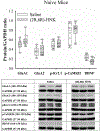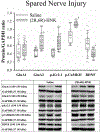A Pharmacological Evaluation of the Analgesic Effect and Hippocampal Protein Modulation of the Ketamine Metabolite (2R,6R)-Hydroxynorketamine in Murine Pain Models
- PMID: 37319016
- PMCID: PMC10721716
- DOI: 10.1213/ANE.0000000000006590
A Pharmacological Evaluation of the Analgesic Effect and Hippocampal Protein Modulation of the Ketamine Metabolite (2R,6R)-Hydroxynorketamine in Murine Pain Models
Abstract
Background: The ketamine metabolite (2R,6R)-hydroxynorketamine ([2R,6R]-HNK) has analgesic efficacy in murine models of acute, neuropathic, and chronic pain. The purpose of this study was to evaluate the α-amino-3-hydroxyl-5-methyl-4-isoxazole-propionate (AMPA) dependence of (2R,6R)-HNK analgesia and protein changes in the hippocampus in murine pain models administered (2R,6R)-HNK or saline.
Methods: All mice were CD-1 IGS outbred mice. Male and female mice underwent plantar incision (PI) (n = 60), spared nerve injury (SNI) (n = 64), or tibial fracture (TF) (n = 40) surgery on the left hind limb. Mechanical allodynia was assessed using calibrated von Frey filaments. Mice were randomized to receive saline, naloxone, or the brain-penetrating AMPA blocker (1,2,3,4-Tetrahydro-6-nitro-2,3-dioxobenzo [f]quinoxaline-7-sulfonamide [NBQX]) before (2R,6R)-HNK 10 mg/kg, and this was repeated for 3 consecutive days. The area under the paw withdrawal threshold by time curve for days 0 to 3 (AUC 0-3d ) was calculated using trapezoidal integration. The AUC 0-3d was converted to percent antiallodynic effect using the baseline and pretreatment values as 0% and 100%. In separate experiments, a single dose of (2R,6R)-HNK 10 mg/kg or saline was administered to naive mice (n = 20) and 2 doses to PI (n = 40), SNI injury (n = 40), or TF (n = 40) mice. Naive mice were tested for ambulation, rearing, and motor strength. Immunoblot studies of the right hippocampal tissue were performed to evaluate the ratios of glutamate ionotropic receptor (AMPA) type subunit 1 (GluA1), glutamate ionotropic receptor (AMPA) type subunit 2 (GluA2), phosphorylated voltage-gated potassium channel 2.1 (p-Kv2.1), phosphorylated-calcium/calmodulin-dependent protein kinase II (p-CaMKII), brain-derived neurotrophic factor (BDNF), phosphorylated protein kinase B (p-AKT), phosphorylated extracellular signal-regulated kinase (p-ERK), CXC chemokine receptor 4 (CXCR4), phosphorylated eukaryotic translation initiation factor 2 subunit 1 (p-EIF2SI), and phosphorylated eukaryotic translation initiation factor 4E (p-EIF4E) to glyceraldehyde 3-phosphate dehydrogenase (GAPDH).
Results: No model-specific gender difference in antiallodynic responses before (2R,6R)-HNK administration was observed. The antiallodynic AUC 0-3d of (2R,6R)-HNK was decreased by NBQX but not with pretreatment with naloxone or saline. The adjusted mean (95% confidence interval [CI]) antiallodynic effect of (2R,6R)-HNK in the PI, SNI, and TF models was 40.7% (34.1%-47.3%), 55.1% (48.7%-61.5%), and 54.7% (46.5%-63.0%), greater in the SNI, difference 14.3% (95% CI, 3.1-25.6; P = .007) and TF, difference 13.9% (95% CI, 1.9-26.0; P = .019) compared to the PI model. No effect of (2R,6R)-HNK on ambulation, rearing, or motor coordination was observed. Administration of (2R,6R)-HNK was associated with increased GluA1, GluA2, p-Kv2.1, and p-CaMKII and decreased BDNF ratios in the hippocampus, with model-specific variations in proteins involved in other pain pathways.
Conclusions: (2R,6R)-HNK analgesia is AMPA-dependent, and (2R,6R)-HNK affected glutamate, potassium, calcium, and BDNF pathways in the hippocampus. At 10 mg/kg, (2R,6R)-HNK demonstrated a greater antiallodynic effect in models of chronic compared with acute pain. Protein analysis in the hippocampus suggests that AMPA-dependent alterations in BDNF-TrkB and Kv2.1 pathways may be involved in the antiallodynic effect of (2R,6R)-HNK.
Copyright © 2023 International Anesthesia Research Society.
Conflict of interest statement
Conflicts of Interest: See Disclosures at the end of the article.
Figures





References
-
- Cohen SP Bhatia A Buvanendran A et al. Consensus Guidelines on the Use of Intravenous Ketamine Infusions for Chronic Pain From the American Society of Regional Anesthesia and Pain Medicine, the American Academy of Pain Medicine, and the American Society of Anesthesiologists. Reg Anesth Pain Med 2018; 43:521–46. - PMC - PubMed
-
- Schwenk ES, Viscusi ER, Buvanendran A, et al. Consensus Guidelines on the Use of Intravenous Ketamine Infusions for Acute Pain Management from the American Society of Regional Anesthesia and Pain Medicine, the American Academy of Pain Medicine, and the American Society of Anesthesiologists. Reg Anesth Pain Med. 2018;43:456–466. - PMC - PubMed
-
- Humo M, Ayazgök B, Becker LJ Waltisperger E Rantamäki T Yalcin I: Ketamine induces rapid and sustained antidepressant-like effects in chronic pain induced depression: Role of MAPK signaling pathway. Progress in Neuro-Psychopharmacology and Biological Psychiatry 2020;100:109898. doi: 10.1016/j.pnpbp.2020.109898 - DOI - PubMed
MeSH terms
Substances
Grants and funding
LinkOut - more resources
Full Text Sources
Research Materials
Miscellaneous

